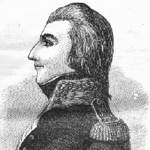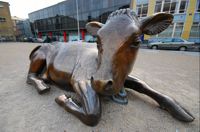Wolfe Tone Park St. Mary's Chruchyard

St Mary's Graveyard (Wolfe Tone Park), Artist Impression
Wolfe Tone Park is located on the site of the old St Mary’s Churchyard: the cemetery attached to the church on Mary Street. For almost three centuries the park served the community and its visitors as a place to respect the dead and, later, a place to embrace the living.
In 1718, six enlightened surgeons1 established the first voluntary hospital in the UK & Ireland, ‘The Charitable Infirmary’. The magnificent Jervis Street Hospital was the realisation of their vision, and the beginning of a charitable movement that Dublin, and Ireland, is renowned for today.
The initiative was the inspiration for many more Dublin hospitals built around that time.
Did You Know?
Handel’s first performance of The Messiah, 1741, was a fundraiser for the Jervis Street & Mercer hospitals.
The funds for these new hospitals were generated by the good people of Dublin who, bound by a sense of social responsibility, invested in their own communities.
In fact, Handel’s first performance of Messiah, 1741, was a fundraiser for the Jervis Street & Mercer hospitals.
The Jervis Street hospital survived independently and entirely on donations until the establishment of the Irish Republic in 1922. Only months earlier, as the city tore itself apart, the wounded found sanctuary here, under the same care given to their enemy; just as it had been for the soldiers and rebels who escaped to ‘The Jerv’ in Easter 1916. The hospital then operated with state intervention until services were relocated to the new Beaumont Hospital in 1987.
Theobald Wolfe Tone was born and educated across the park on Stafford Street; now Wolfe Tone Street. He was baptised in the nearby church on Mary Street. So too were playwright Sean O’Casey and the Earl of Charlemont (Irish Volunteers).
The churchyard became the final resting place of famous and infamous parishioners2 before being utilised as a park and playground in 1940.
By 1966 the park was transferred to Dublin Corporation who, commemorating the fiftieth anniversary of the Easter Rising, renamed the ground ‘Wolfe Tone Memorial Park’.
Today local residents share fond memories of that park as their childhood playground and communal garden, while photographs reveal the old park as a popular sanctuary for respite in a busy city-centre.
1Dr. Steevens' Hospital (1733). Mercer's Hospital (1734), the Rotunda (1745), the Meath Hospital (1753), St. Patrick's Hospital (1753), and Sir Patrick Dun's Hospital (1792).
2 United Irishman Archibald Hamilton Rowan (1751-1734); Mary Mercer, founder of Mercer's Hospital (died 1734); Philosopher Francis Hutcheson (1694-1746); Lord Norbury (1745–1831), the “Hanging Judge”; Sir Boyle Roche (1736–1807), an Irish politician.
Wolfe Tone regarded as the father of modern Irish Republicanism

Born : 20 June 1763 Dublin, Ireland
Baptised: Theobald Wolfe Tone in Mary's Church on Jervis Street, Dublin
Died : 19 November 1798 (aged 35) Provost's Prison, Dublin
Allegiance: Society of United Irishmen
Years of service: 1791–1798
Rank: Adjutant General
Spouse: Matilda Fanning
Wolfe Tone was one of the leaders of the United Irishmen. He was born in Dublin in 1763 and became a lawyer. He was a Protestant yet like many of the leaders of the United Irishmen he wanted to seek rights for his Presbyterian and Catholic countrymen.
Our independence must be had at all hazards
If the men of property will not support us they must fall
We can support ourselves by the aid of that numerous and respectable class of the community
The men of no property.
- Theobald Wolfe Tone.
In 1795, Wolfe Tone left Ireland for America to escape arrest. He then went to France requesting soldiers to help with a revolution in Ireland. In 1796, Wolfe Tone sailed from France to Ireland with a fleet of thirty-five ships and about 15,000 soldiers. However, the ships got caught in terrible storms. Some ships sank and the sailors were lost. Many French ships waited off Bantry Bay for calmer weather but in the end they returned to France.
Tone himself had sailed in a French raid at Donegal in October 1798 but was captured, taken to Dublin and court-marshalled. He requested that he be afforded the death of a soldier, to be shot, rather than hanged. His request denied he died in Provost's Prison in Dublin of a neck wound in November 1798 at the age of 35 years.
Jervis Street Hospital Oldest Voluntary Hospital in Ireland & Great Britain.

Founded: The Charitable Infirmary (1718)
Building Completed : 1796, on 14 Jervis Street, Dublin
West Facade: 1885
Hospital Service : 1796 - 1987
Decommissioned: 1989
Commercial & Residential Development: 1996
The Charitable Infirmary is the oldest voluntary hospital in Ireland and Great Britain. Founded in 1718, it served the citizens of Dublin for 270 years. Over it's three centuries of existence it was witness to the social and cultural vicissitudes of a city that witnessed the splendour and poverty of the Georgian era, the depression following the Act of Union, the excitement of Catholic Emancipation, the industrial and scientific progress of the Victorian age, the misery of the Great Famine, the Easter Rebellion and the Civil War, and lastly the dramatic social changes that characterised the history of the ninetieth century.
The hospital was closed in 1987 and the site redeveloped as a shopping centre, car park and apartments that opened in 1996.

Inside the Jervis St. Hospital, 1890

Jervis St. Hospital, 1903

Inside the Jervis St. Hospital, c.1900

Inside the Jervis St. Hospital, c.1900

Jervis St. Hospital, c.1920

Inside the Jervis St. Hospital, c.1930

Inside the Jervis St. Hospital, c.1987

Inside the Jervis St. Hospital, c.1987

Inside the Jervis St. Hospital, c.1987

Wolfe Tone Park & Jervis St. Hospital, July 1990

Wolfe Tone Park, 2005

Wolfe Tone Park, 2015
Wolfe Tone Park Community

The Wolfe Tone Park Community is a non-commercial community-based initiative established to protect Wolfe Tone Park.
Agenda:Full Restoration of Wolfe Tone Park as a non-commercial green space (c.2017)
Protect the park from commercial targeting (2016)
Protect the park from DCC/BID 'Tram Cafe' proposal (on-going)
Monitor any proposals or plans for the park (on-going)
Protect the park from 2017 DCC/BID 'Frankenstein' renovation (on-going)
Inclusion of Park Restoration in Dublin City Draft Development Plan 2016-2022 (16-Sept-15)
Prevent commercial vehicles from parking in the public space (21-Dec-15)
Secure the Park Status of Wolfe Tone Park (not Square) (21-Dec-15)
Prevent amplified music festivals taking place in the park (01-Nov-15)
Removal of DCC 'mobile' staff toilets from west side of the park (15-Oct-15)
Removal of BID/DublinTown kiosks from within the park (01-Oct-15)
Removal of commercial furniture from within the park (10-Nov-15)
Prevent Dublin City Council vehicles from vandalising old tombstones around the park (16-Sept-15)
Establish direct contact with DCC management regarding park condition & neglect (01-July-15)
